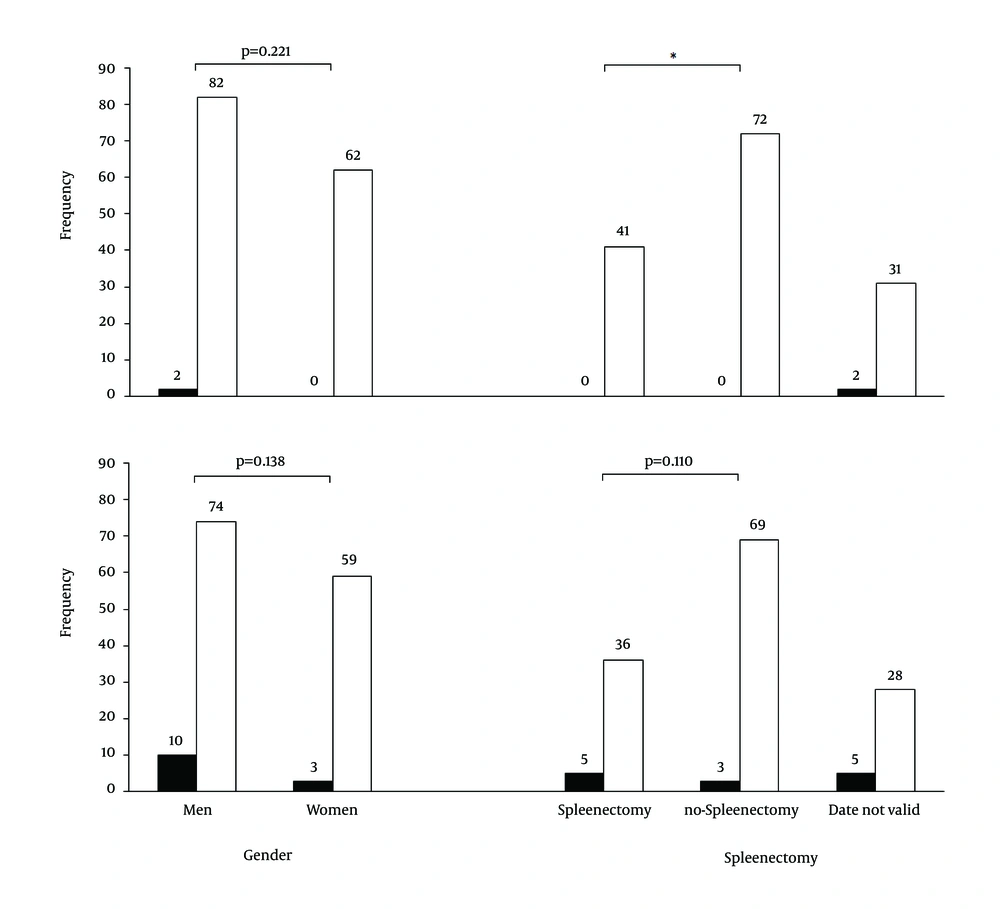Hemophilia population is one of the most endangered people, being infected with blood-borne diseases via blood (or its products) transfusion. The aims of this study was to evaluate and compare the seroprevalence of hepatitis B virus (HBV), hepatitis C virus (HCV) and HBV/HCV co-infection in hemophilia patients as the population at risk of viral hepatitis infections.
One hundred and forty-six patients with hemophilia who referred to the two main hospitals of Fasa City, Fars Province, Iran during 2007 - 2013 were selected (male to female ratio of approximately 1:1). These patients were checked for HBV and HCV infection using Hepatitis B surface antigen (HBsAg) and anti-HCV antibody (IgG) assay through ELISA method. SPSS software was used for data analyses.
Our sample comprised 57% men and 43% women with the mean age of 20.4 ± 11.9 years (age range from 0.08 - 84 years). The prevalence of HBV and HCV infection in patients with hemophilia were 1.4% (2 patients) and 8.9% (13 patients), respectively. No patient with HBV/HCV coinfection was detected and also, there were no correlation between gender and having splenectomy with the prevalence of both HBV and HCV infections.
The prevalence of HBV and HCV infections among patients with hemophilia found in this study was in line with approximately all other previous reports from other regions of Iran and this means that both HCV and HBV can be a serious problem in patients with hemophilia. However, further studies in other regions with higher patient number and other detecting methods are highly recommended.
Hemophilia A and B are rare hereditary bleeding disorders, which are caused by mutations in the factor VIII and IX genes (1). Hemophilia could be treated with the whole blood or blood products (2). However, blood transfusion is the main risk factor for transmitting some viruses, such as hepatitis B virus (HBV), hepatitis C virus (HCV), and human immunodeficiency virus (HIV) (3). Hepatitis B, caused by HBV, is the most prevalent cause of human liver disease (4), while, hepatitis C, caused by HCV, is one of the most common chronic blood-borne infections (5). The aims of this study were to determine and compare the prevalence of HBV, HCV infections and HBV/HCV coinfection in patients with hemophilia living in Fasa, southern part of Iran.
In this cross sectional single-centre descriptive study, 146 patients diagnosed with hemophilia A, were enrolled. They were treated and registered from 2007 - 2012 and referred to two main hospitals of Fasa. This study was approved by ethics committee of the Fasa university of medical sciences and written informed consent was obtained from each patient. Fasting blood samples were taken into sterile vacutainers without anticoagulant and after centrifugation (2000 g, 10 minutes), their serums were obtained. HBsAg and immunoglobulin G (IgG) antibodies against HCV were detected using Enzyme-linked immunosorbent assay (ELISA) (Dia. Pro, Diagnostic Bioprobes Srl, Italy).
All statistical analyses were carried out using SPSS software, version 16.0 (SPSS Inc., Chicago, IL, USA) for Windows. One-sample Kolmogorov-Smirnov test was used to test for normality of distribution of the collected data. All data were expressed as frequency (percentage) and age for all evaluated parameters were expressed as mean ± standard error of mean (SEM). Correlation analysis was performed to evaluate the relationship between sex and having splenectomy with prevalence of both HBV and HCV infections. P < 0.05 was considered as significant difference.
The prevalence of HBV and HCV infections in hemophiliacs were 1.4% and 8.9%, respectively. No patients with or without HBV and HCV infections had coinfection with HIV. Also, no HBV/HCV coinfection was detected in patients with hemophilia A.
The correlation between either gender or splenectomy and HBV or HCV infection were shown and compared in Figure 1. There was no significant correlation between gender or splenectomy and HBV or HCV infection (P > 0.05). Our patients were categorized into two age groups, lower and higher than 20 years. The correlation analysis between age and HBV/HCV infections demonstrated that there were no significant differences in the prevalence of either HBV or HCV infections with respect to lower or higher than 20 years age groups (P = 0. 860 and P = 0. 178 for HBV and HCV infections, respectively).
This is the first cross sectional study in Fasa, south of Iran conducted on the prevalence of HBV and HCV infection in hemophiliacs. These patients are potential carriers of HBV and HCV and can infect other people via several routes, so conducting epidemiological studies on these types of patients has high value and importance. Because of the relatively high prevalence of HBV in Iranian population, this virus remains a major challenge for blood transfusion in Iranian Blood Transfusion Organization (IBTO) and according to the world health organization classifications, Iran with a prevalence rate of around 3.0% (2.5% - 3.5%) HBs-Ag seropositivity in its population is classified as intermediate for HBV infection (6). In a recent study, the rate of HCV seropositivity for rural population of Kavar city in Fars Province was reported as 0.24% (7). Also, prevalence of HCV in blood donors in different countries of the developed world has been reported to be between 0.3% and 1.5% (8). However, the prevalence of HCV infection in patients with hemophilia in Iran ranged between 29% - 83.3% with the lowest rate reported in Zahedan and the highest in Tehran (9, 10). In Iran, the prevalence of HBV and HCV infection in the hemophiliacs ranges from 0.7% - 27% and 15%-80%, respectively (11). In 2012, Assarehzadegan et al. in their study reported the prevalence of 1.1% for HBs-Ag and 54% for HCV in Ahvaz, southern part of Iran (11). Our finding (prevalence) is consistent with all reported prevalences, which shows the similar prevalence of this disease in Fasa, southern part of Iran with regard to other regions of Iran. However, we did not perform polymerase chain reaction and had no history of antiviral treatment, which means that there might be an overestimation of HCV prevalence.
